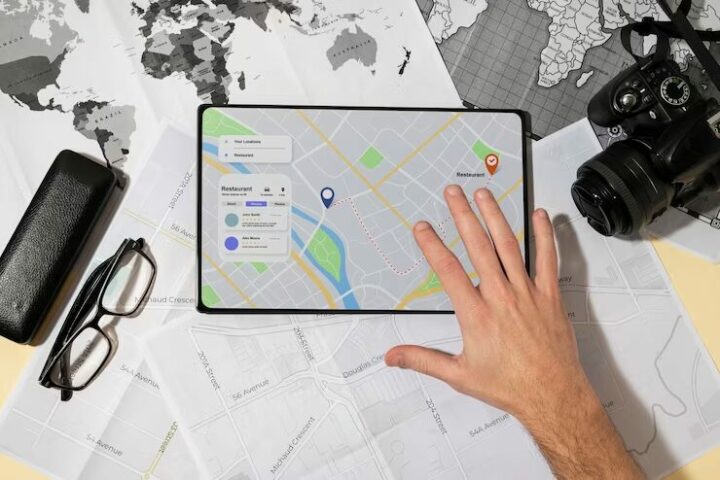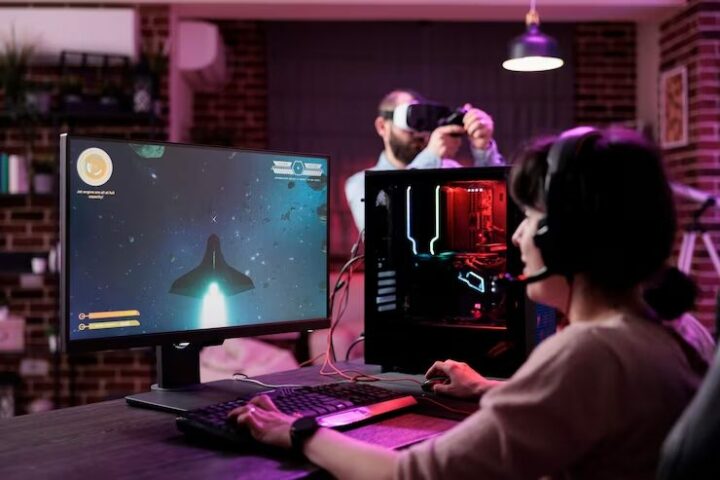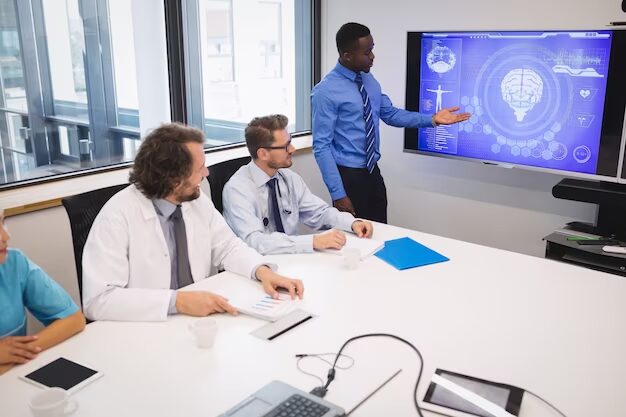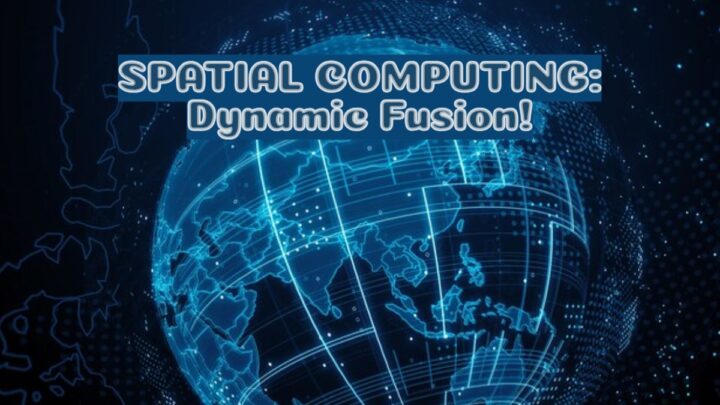Ever thought of a world where the digital and physical come together, like a secret meeting of two universes? It’s not science fiction but it’s Spatial Computing! Have you ever felt the urge to touch the virtual and see the imaginary? Well, buckle up because Spatial Computing is the magic portal to make that happen. It’s like turning your everyday space into a playground of endless possibilities. You’re not just learning about things; you’re living them. So, hold on tight as we move on this mind-bending journey where pixels meet the real world, and the ordinary transforms into the extraordinary! Welcome to the concept where reality gets a dazzling upgrade!
What will you see here?
Introduction to Spatial Computing
Spatial Computing is a groundbreaking paradigm that blurs the lines between the physical and digital worlds, ushering in a new era of exciting and interactive experiences. A world where your surroundings become a canvas for technological innovation, where the tangible and virtual seamlessly coexist. This transformative concept goes beyond traditional computing, turning our everyday spaces into dynamic, intelligent environments. Although at its core, Spatial Computing relies on fantastic technologies like sensors, cameras, and geospatial mapping to understand and interpret the physical world. It’s about creating a synergy between our real-world surroundings and digital information, opening up a world of possibilities for how we perceive and interact with our environment.
One of the key components of Spatial Computing is Augmented Reality (AR), which overlays digital information into our physical reality. This can range from simple data overlays to more complex three-dimensional models integrated into our surroundings. Virtual Reality (VR) is another integral part, offering fully involved experiences by transporting users to entirely digital environments. This way what makes Spatial Computing truly remarkable is its ability to enhance user experiences by providing context-aware and personalized interactions. Whether it’s navigating through augmented cityscapes or collaborating with colleagues in virtual spaces, Spatial Computing enriches our daily lives.
Key Components
Come along on a journey through the intricate machinery that brings the enchanting world of Spatial Computing to life. In our exploration, let’s uncover the essential elements that make this groundbreaking technology tick. Our first stop is Sensing Technologies. Imagine these digital senses, like cameras and motion detectors, as the heart of Spatial Computing. They meticulously capture the details of the real world, working together to create a beautiful dance between the physical and digital realms. This collaboration sets the stage for meaningful experiences that reshape the way we interact and move to the world around us. Starting with the crucial foundation provided by Sensing Technologies!
Sensing Technologies

Sensing technologies are the unsung heroes in the exciting world of Spatial Computing, serving as the eyes and ears that allow the physical and digital worlds to coexist seamlessly. Spatial Computing is fundamentally based on the ability to feel and understand the real world, and sensing technologies play an important part in achieving this. These technologies include a diverse range of sensors, cameras, and gadgets used to sense and understand the surroundings. Consider a complex network of digital senses that can detect movement, depth, and temperature, and even recognize objects or gestures. These sensors serve as Spatial Computing’s nerve endings, gathering real-world data to lay the groundwork for immersive and context-aware experiences.
Depth-sensing cameras, for example, may map a room’s three-dimensional structure and help Spatial Computing systems grasp the spatial relationships between items and surfaces. Motion sensors can accurately capture movements, allowing augmented reality apps to respond to a user’s gestures or actions. These sensing technologies give critical data points, allowing Spatial Computing devices to make sense of the physical world in real time. In essence, sensing technologies convert our surroundings into a data canvas, recording the complexities of the world with pinpoint accuracy. This data serves as the foundation for overlaying digital information, developing augmented reality experiences, and transporting users to virtual worlds in virtual reality. The magic of Spatial Computing truly begins with these sensors, as they bridge the gap between the tangible and the digital, opening the door to an environment where reality and imagination harmoniously coexist.
Augmented Reality (AR) and Virtual Reality (VR)

Augmented Reality effortlessly integrates digital overlays into our physical environment, providing contextual information and interactive features. Virtual Reality, on the other hand, puts users completely in digitally generated worlds, overcoming the physical world’s limitations. These technologies are more than just novelties; they are revolutionary features of Spatial Computing. AR and VR use sophisticated sensor technology to understand the complexities of the physical environment, introducing layers of digital data or transporting users to virtual worlds. Whether it’s navigating augmented cityscapes or engaging in realistic training simulations, AR and VR are expanding the range of possibilities.
As we analyze the fundamental components of Spatial Computing, Augmented, and Virtual Reality emerge as a route to new experiences. Beyond their entertainment value, these technologies transform sectors by providing unprecedented degrees of immersion and interaction. In education, they bring textbooks to life by immersing students in historical events. In healthcare, they provide elaborate simulations for medical training.
Geospatial Mapping and Tracking

Geospatial Mapping and Tracking emerge as indispensable pillars within the realm of Spatial Computing, illuminating the path toward a more sophisticated and context-aware digital landscape. At its core, this key component involves the meticulous mapping and tracking of physical spaces, transcending traditional boundaries to enhance our understanding and interaction with the environment. Geospatial Mapping entails the creation of intricate digital maps that mirror the three-dimensional structure of the real world. Utilizing advanced technologies such as GPS, LiDAR, and sensors, Spatial Computing systems capture the spatial layout of physical spaces with remarkable precision. This mapping lays the groundwork for a more nuanced and immersive digital augmentation of reality.
Tracking, on the other hand, involves monitoring the movements and interactions within these mapped spaces. From the trajectory of a user navigating a city block to the subtle gestures within an augmented environment, tracking technologies contribute to the creation of dynamic and responsive digital experiences. This real-time tracking capability is particularly crucial for augmented reality applications, where digital information is seamlessly overlaid onto the physical world. Together, Geospatial Mapping and Tracking enable a comprehensive understanding of the user’s context, allowing for the delivery of content and information in a highly relevant and personalized manner. The implications of this component extend across various sectors, from location-based services and augmented navigation to immersive gaming experiences. In essence, Geospatial Mapping and Tracking empower Spatial Computing to bridge the gap between the physical and digital realms, creating a cohesive and interactive fusion that redefines our engagement with space and information.
Applications
Spatial Computing transforms imagination into tangible experiences. The diverse applications of this groundbreaking technology, the digital and physical converge to redefine how we live, learn, work, and play. From graceful gaming adventures to revolutionizing healthcare simulations, the applications of Spatial Computing are not just futuristic dreams – they’re unfolding realities, ready to resolve and reshape the way we interact with our surroundings.
Spatial Computing in Gaming

Spatial Computing’s impact on gaming is profound, introducing a new era of immersion where players aren’t just observers but active participants in their digital adventures. Using advanced sensing technologies, Spatial Computing captures the nuances of physical movements, translating them into responsive and dynamic in-game actions. Whether it’s ducking behind cover in a virtual shootout or physically exploring a fantasy landscape, Spatial Computing elevates gaming to unprecedented heights. Spatial Computing doesn’t just enhance gaming; it reinvents it. It’s a paradigm shift that invites players to step into the game, blurring distinctions between the virtual and the real. The extraordinary landscapes of Spatial Computing in gaming, where every move, every gesture, and every moment becomes an integral part of the gameplay experience. Welcome to the future of interactive gaming, where Spatial Computing is the game-changer.
Spatial Computing in Healthcare

One notable application of Spatial Computing in healthcare is in medical training simulations. This not only enhances training effectiveness but also contributes to improved patient outcomes. By ensuring that healthcare practitioners are well-prepared and skilled. In diagnostics, Spatial Computing aids in visualizing medical imaging data in three-dimensional space. This allows healthcare professionals to explore and analyze complex medical images, such as CT scans and MRIs, with greater clarity and depth.
The ability to manipulate and interact with these images in a three-dimensional space enhances diagnostic accuracy and facilitates more informed decision-making. Patient care is also positively impacted by Spatial Computing. AR applications can provide real-time information to surgeons during procedures, offering guidance on precise incision points or displaying vital patient data. VR, on the other hand, has been employed in therapeutic interventions. Offering immersive experiences to patients for pain management, mental health treatment, and rehabilitation.
Spatial Computing for Navigation

Spatial Computing takes center stage in revolutionizing navigation, transcending conventional methods to redefine how we traverse and explore the world. However, in this application, Spatial Computing leverages advanced geospatial mapping, real-time tracking, and augmented reality technologies to enhance traditional navigation systems. Imagine navigating through a city where digital overlays provide dynamic and context-aware information. Guiding you seamlessly through streets, landmarks, and points of interest. With Spatial Computing in navigation, the mundane act of getting from point A to B becomes an immersive and personalized journey, offering not just directions but a richer understanding of your surroundings. This technology transforms navigation into an interactive experience, where the digital and physical worlds blend harmoniously to elevate the way.
Collaboration and Social Interaction
Spatia l Computing transforms collaboration and social interaction by introducing a spatial context to our digital engagements. It’s no longer just about exchanging information; it’s about coexisting in a shared virtual environment, where gestures, and expressions. And movements are integral parts of the interaction. This application extends the boundaries of communication, making remote collaboration feel more tangible and social interactions more exciting. In essence, Collaboration and Social Interaction in Spatial Computing mark a significant stride toward a more connected and engaging digital future.
It extends its transformative touch into the social sphere, redefining how we connect and collaborate in virtual spaces. This application envisions a future where digital environments become dynamic arenas for shared experiences. Bridging the physical gaps that separate individuals. Through augmented reality (AR) and virtual reality (VR). Spatial Computing facilitates immersive and interactive collaborations. By allowing people to interact seamlessly across distances.
How is Spatial Computing different from AR and VR?
Spatial Computing is a holistic strategy that merges digital and physical settings, to improve real-world interactions. By smoothly incorporating digital information into the user’s perception of their surroundings. Augmented Reality (AR) is a Spatial Computing application that overlays digital content in the real-world environment to complement the user’s view. In contrast, Virtual Reality (VR) produces a completely immersive, isolated digital environment. As a broader idea, Spatial Computing includes both AR and VR. Emphasizing context-aware experiences that improve the user’s awareness and interaction with the actual world using sensors and geospatial mapping technologies.
Impact of Spatial Computing on Education?
Spatial computing has a transformative impact on education, providing novel ways to improve learning experiences. Students can engage with immersive and interactive content by incorporating Spatial Computing technologies into educational settings. Such as augmented reality (AR) and virtual reality (VR). Spatial computing allows for the creation of virtual learning environments that model complicated concepts, historical events, or scientific phenomena, giving students hands-on experiences that would be difficult to recreate in regular classrooms.
This technology also enables personalized learning by catering to different learning styles and collaborative experiences that promote teamwork and communication. Furthermore, Spatial Computing promotes distance learning by allowing remote students to participate in enticing educational activities. Overall, it transforms the educational landscape by making learning more entertaining, accessible, and personalized to each individual.
Conclusion
Spatial computing is more than simply graphics and algorithms; it is about improving our experiences and elevating the ordinary. It is a technology that transforms our surroundings into canvases of limitless possibilities, where information blends effortlessly with our reality. Spatial Computing is more than a technology; it’s a portal to different dimensions. As we approach the end of our voyage through this enthralling terrain. One thing becomes clear: Spatial Computing is more than a technological advancement; it is a paradigm revolution.
It’s a shift in the way we perceive, engage, and collaborate. The convergence of digital and physical is no longer a distant future. It is arrived, revolutionizing the way we live, work, and communicate. In Spatial Computing’s grand finale, the every day becomes spectacular. The digital becomes physical, and the future becomes a fully enveloping reality. Welcome to the period where the barriers between the real and the virtual disappear. And Spatial Computing reigns as the orchestrator of our digital destinies!
















